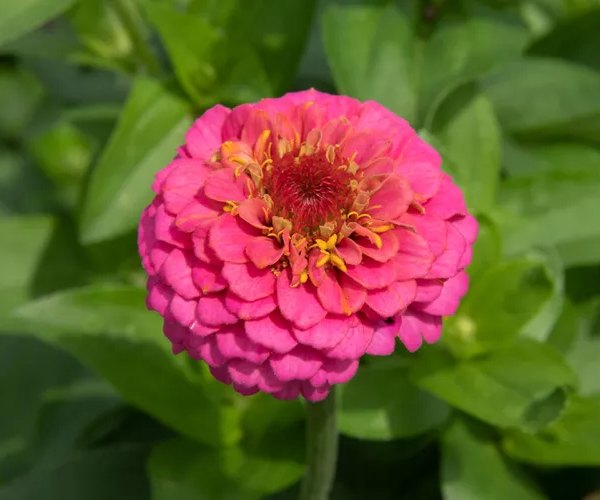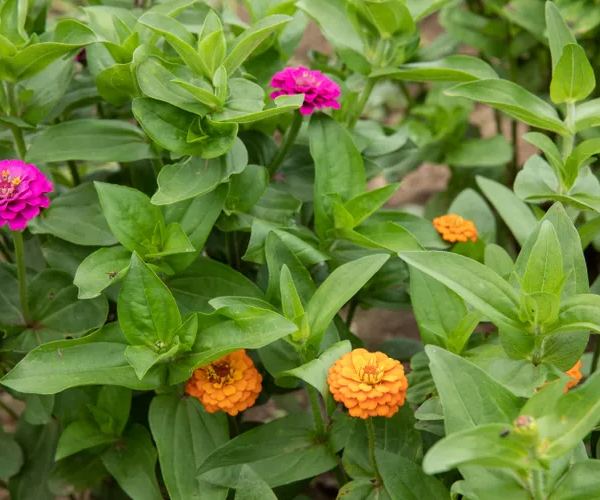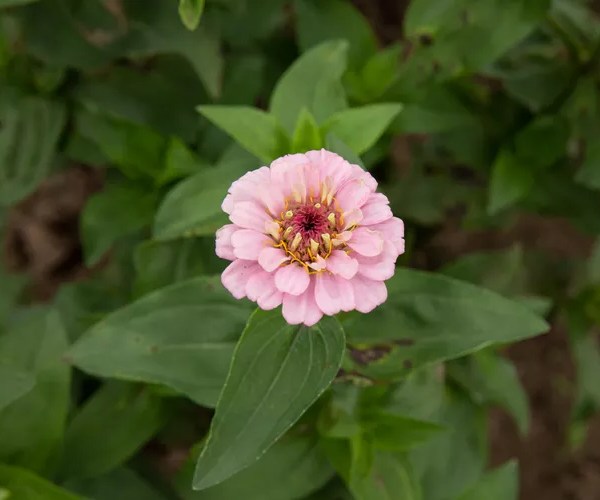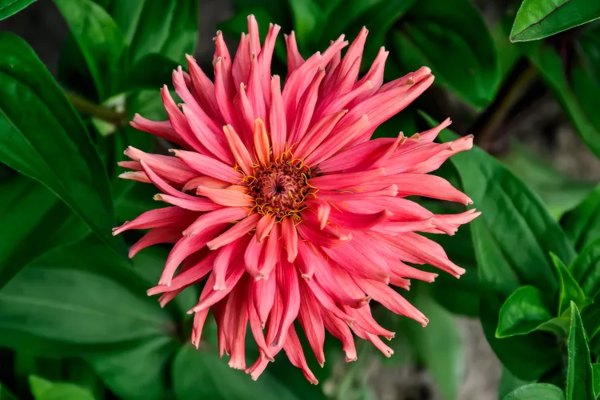If you love colorful and low-maintenance flowers like everybody else, then zinnias are the one for your garden. These annuals have bright hues which are very low-maintenance and provide beautiful blooms to cut and show off in your home.
Zinnias are not only pretty but also easy to grow. Still, they are also heat and drought-tolerant. Gladys Mbofung-Curtis, a garden expert at Garden Safe, says, “They are great for hot summer weather and gardeners in warmer climates,’‘ adding, ”Zinnias are one of the easiest flowers to grow because seeds require only basic garden preparation to sprout, and the plants flower in just a few weeks. They can flourish with very little fertilizer and still produce flowers.”
Varieties of Zinnias
Plants in the Zinnia genus are members of the Asteraceae family. They also include daisies and asters. Venelin Dimitrov of Burpee says, “The flowers bloom in a range of shapes, including quilled, dahlia-type, single, semi-double, and double flowers.’‘ He added, ‘‘Plus, they are excellent flowers for new gardeners and children to grow, as the seeds are large and easy to handle, and the flowers often attract many species of butterflies.”
Sabrina Schirtzinger, extension educator at Ohio State University reveals some of the most popular zinnia varieties grown in backyard gardens:
- Benary Giant: These large, eye-catching double flowers grow up to 39 inches tall in about nine weeks.
- Oklahoma: Oklahoma zinnias can be double or semi-double blooms and boast a range of hues that include dusty pink, bright gold, and regal purple.
- Cactus: Instead of the rounded shape of other zinnias, the Cactus variety boasts spiky petals on 5-inch-wide blooms that sit atop 3-foot-tall stems.
- State Fair: Disease-resistant State Fair zinnias grow up to 6 inches across and come in vivid, warm shades ranging from pink to yellow.
She loves the flower for its varieties of shapes and sizes and colors, of course. She also appreciates its fast, reliable growth habits low-maintenance needs, and sturdy stem which is great for harvesting. “Zinnias are dependable, low-maintenance, and have vibrant colors!” she says. “For a constant cut flower supply, plant in succession by sowing every two weeks.”

How to Grow Zinnias from Seed
If you live in warm climates, you can directly seed into the soil after the danger of frost has passed, according to Mbofung-Curtis. She also says that seeds can be started indoors in germination trays in cooler areas.
“Whether seeding directly in beds or germination trays, zinnia seeds should be sown to a depth of a 1/4-inch into deep, loamy soil,” she says. “The distance between seeds or seedlings in the beds should be about 6 inches apart for good airflow, and rows should be spaced 12 inches apart.”
She also mentioned that zinnia seeds can also be sowed directly in mulch into 1 to 2 inches of organic mulch as they will provide essential nutrients throughout the season. It happens as the mulch breaks down to form compost with time.
How to Care for Zinnias
Zinnias are annuals that grow fast but only last for one season.
Fortunately, these plants are super easy to grow. Below, we have mentioned how you can take care of this special flowering plant.
- Choose a sunny area that gets at least six hours of direct sunlight daily.
- Plant in a nutrient-rich, well-draining soil.
- Water occasionally, though these plants are fairly drought-tolerant.
- Feeds your zinnias once or twice throughout the growing season, but as annuals, zinnias don’t need much fertilizer.
Sunlight
Zinnias love full sunlight and it is best to plant them at the start of the warm weather season. “They are short-day plants that flower when the day length is less than 11 hours; therefore, they are perfect for early spring planting when the nights are longer,” Mbofung-Curtis says. “Zinnias grow and flourish well in full sunlight in cooler climates, but in warmer climates, occasional afternoon shade may help relieve the plants from the excessive heat.”
Also, Read What is Variegated Plants? Here’s What You Need to Know!
Watering
As we mentioned earlier, these plants can be drought-tolerant for some time but Mbofung-Curtis says they’ll grow best in moist soil. “Water plants about three times a week so that the soil stays moist to about 6 to 8 inches deep,” she says. For potted plants, she recommends only watering when the soil feels dry.
Soil
Zinnias love well-drained, neutral, and a bit acidic soil that has a pH between 5.5 and 7.5. “Once zinnias are established, mulching with a 2-inch layer of straw or bark will help preserve soil moisture and prevent weed growth,” says Mbofung-Curtis.

Fertilizer
While zinnias can do well in average soils, Mbofung-Curtis says they’ll perform better with the help of compost or fertilizer. “A light fertilizer may be applied at the seedling stage,” she says. “At flowering, side dressing with an organic 5-5-5 fertilizer will produce numerous and bigger blossoms.”
How to Prune Zinnias
A little pruning can be very helpful for zinnias in your garden. “The more you cut zinnia blooms off, the more flowering will occur,” says Schirtzinger. “Pinch zinnias when the first buds appear, back to above the leaf axil. This aids in producing long stems.”
How to Harvest Zinnias
It is necessary to know that zinnias thrive when their blooms are trimmed off, making them an ideal part of your cutting garden. “Rather than allowing flowers to be spent on the plants before deadheading, cut the mature flowers for use in bouquets to encourage blossoming throughout the season,” Mbofung-Curtis says.
Schirtzinger says the best time to cut zinnias is in the evening or in the morning when any overnight moisture has evaporated. “Harvest before the flower completely opens with a firm stem,” she says. “Cut stems as long as possible, strip excess foliage, and place in cool water.”
Since zinnias are annuals, they do not need winterizing. Schirtzinger says that saving seeds in the fall can take place with open-pollinated varieties.
Common Problems with Zinnias
Keeping Zinnias well-drained is the easiest way to get the best results. “Overwatering and continuous wet conditions can take a great toll since high humidity can lead to the development of powdery mildew, leaf spots, and rot, so water at the base of the plants,” Mbofung-Curtis says.

Schirtzinger says aphids, Japanese beetles, and thrips are the common threats to zinnias and advises watering from the roots and not from above. “Limiting soil splashing onto the foliage helps decrease foliar disease,” she says.
Propagating Zinnias
There are many ways how you can propagate zinnias; by division or through cuttings. Here is how you can propagate zinnias by taking a cutting which is best if done in spring:
- Take a healthy, 6-inch stem that has not yet flowered.
- Remove the leaves from the bottom half of the fresh cutting.
- Keep the cutting in water and wait for roots.
- Once the roots become a few inches long after a few weeks, plant the cutting in moist soil or directly into the ground.
How to Get Zinnias to Bloom
Zinnias are great bloomers that are popular for their colorful flowers which are available in lots of hues and colors.
Bloom Months
Zinnias start flowering in late spring or early summer, mainly June or July depending on the place you live, and they will continue to bloom into fall and until the first frost.
What Do Zinnia Flowers Look and Smell Like?
Colorful zinnias are available in different shapes and sizes and they are normally daisy-like in both single and double forms. They are grown generally for their bright pops of colors and not their scents since they don’t offer much of a fragrance.
How to Encourage More Blooms
Firstly, be sure to plant your zinnias in a spot where they’ll receive full sunlight because these plants are sun lovers. Also, try starting them out from seed, which often leads to more blooms.
If yours has gotten about a foot tall, pinch the main growth as that will promote branching and increase blooms. Lastly, deadhead them throughout the summer to keep them flowering.
FAQs
Q: Do zinnias come back every year?
A: No, as true annuals, zinnias will not come back next year, regardless of where you live.
Q: Can you scatter zinnia seeds?
A: Yes, these seeds germinate so easily that they require minimal care. You can scatter them over some well-draining soil (ideally covering them lightly with more soil), water them in, and watch them grow.
Q: Do zinnias like to be crowded?
A: Zinnias are pretty resilient plants and can adapt to a lot of situations. However, ideally, each zinnia plant would like at least six inches of its own space.
Q: How long does it take zinnias to bloom from seed?
A: Zinnias typically take around two months to grow from seed to bloom. Choose a sunny spot when planting and make sure you plant after the last frost of the season. “In the past, I have planted my zinnias at the same time as my tomatoes, and that made for the prettiest summer season in my backyard,” Hewitt says.
Also, Read Should You Add Banana Water and Eggshells to Your Plants? Experts Reveal!
